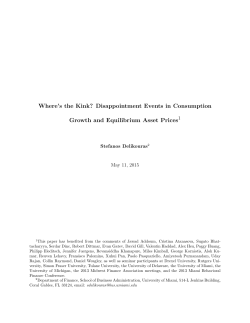
The Impact of Entrepreneurial Risk Aversion on Wages in General
The Impact of Entrepreneurial Risk Aversion on Wages in General Equilibrium∗- A Second Proof Ying Feng¶ UC San Diego James E Rauch‡ UC San Diego, NBER and CESifo March 17, 2015 Let the assumptions in KL theorem 1 (existence) and KL theorem 2 (uniqueness) hold, as well as the assumption in their Lemma (risk aversion increasing in α, not merely non-decreasing). We can then state and prove the following revised version of KL theorem 41 : THEOREM 4 (REVISED). An increase in the Arrow-Pratt absolute risk aversion measure r(I, α) for all α ∈ [0, 1] and for all I lowers the equilibrium wage. PROOF 2: Consider a transformation f (·) of the Arrow-Pratt absolute risk aversion index for agent α such that r0 (I, α) = r(I, f (α)) for all income I, where f (·) satisfies f (x) > x and f 0 (x) ≥ 12 . Thus there is an economy-wide increase in risk aversion: r0 (I, α) > r(I, α) for all I. Then individual α has a risk attitude indexed by f (α) while the functional forms of L(w, ·) solving Max Eu(A + g(L, x ˜) − wL, α). (1) Eu[A + g(L(w(α), α), x ˜) − w(α)L(w(α), α), α] = u(A + w(α), α). (2) L and w(·) defined by stay the same, so the new equilibrium is characterized by α ˆ 0 such that labor market clears, Zαˆ 0 L(w(f (ˆ α0 )), f (α)) dα = 1 − α ˆ0. (3) 0 Suppose new equilibrium wage is unchanged or larger i.e. w(f (ˆ α0 )) ≥ w(α ˆ ), then f (ˆ α0 ) ≤ α ˆ follows since the certainty equivalent wage w(α) is continuous and monotonically decreasing. Recall L is Rαˆ ˆ ), α) dα is increasing a decreasing function of w when holding α fixed, so the integration L(w(α 0 ∗ Our thanks to Alexis Akira Toda and Richard Kihlstrom for helpful comments. We are responsible for any errors. ¶ jenyfeng@ucsd.edu ‡ jrauch@ucsd.edu (econweb.ucsd.edu/ jrauch/ ). 1 Note we are not assuming neither “g(L, x) and gL (L, x) are both monotonically increasing (or decreasing) functions of x”, assumption iii stated in KL theorem 4 above. 2 A rich set of transformations of risk aversion are consistent with this assumption. The easiest example can be f (α) = 2α. 1 in α ˆ . Therefore, Rαˆ L(w(ˆ α), α) dα − (1 − α ˆ ) is a continuous and increasing function of α ˆ . Recall 0 Rαˆ L(w(ˆ α), α) dα = 1 − α ˆ at the old equilibrium and f (ˆ α0 ) ≤ α ˆ , so we get 0 fZ(α ˆ0 ) L(w(f (ˆ α0 )), α) dα ≤ 1 − f (ˆ α0 ). (4) 0 Therefore, Zαˆ 0 L(w(f (ˆ α0 )), f (α)) dα 0 fZ(α ˆ0 ) L(w(f (ˆ α0 )), f (α)) dα < 0 fZ(α ˆ0 ) L(w(f (ˆ α0 )), f (α)) df (α) ≤ 0 Zαˆ 0 = L(w(f (ˆ α0 )), α) dα 0 fZ(α ˆ0 ) L(w(f (ˆ α0 )), α) dα < 0 ≤ 1 − f (ˆ α0 ) <1−α ˆ0 , where the first “≤” follows by assumption f 0 (x) ≥ 1, three “<” follow from f (x) > x and “=” is only a change of integration variable. This inequality shows that if the new equilibrium wage is not smaller, there will be an excess supply of labor, which is a contradiction. So the new equilibrium wage must decline. Q.E.D. References [1] Kihlstrom, Richard E., and Jean-Jacques Laffont.“A general equilibrium entrepreneurial theory of firm formation based on risk aversion.”The Journal of Political Economy (1979): 719748. 2
© Copyright 2025




















